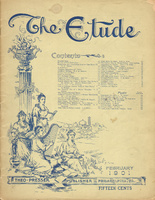The question has again and again been asked as to the proper age for young girls to begin the study of singing. To guard against being misunderstood, I am going to state frankly and with due appreciation of the importance of the subject, that the entirely safe age to begin is from six months to a year after the change has occurred from childhood to womanhood. The safety must then depend upon the skill and extraordinary care of the teacher.
L. M. C.—You preface your statements by asserting that you have a reliable vocal teacher, and then you apparently set out to prove the contrary, in which you succeed perfectly. You would hardly become an opera-singer even in your next incarnation if you depended upon Concone. Either you are inadequately equipped for so demanding a career and your teacher does not acquaint you with the truth, or your teacher does not realize your needs. The responsibility is his in either case. You should study the piano, master sight-singing, do much work in scales, conquer the embellishments, and be in line for promotion to serious interpretation work by the end of your second year, or there is a serious lack either in you or your teacher. It may be both.
Kate.—I cannot write a book, which an intelligent answer to your first question requires, but will, instead, give you a rule. In your study of the slow scale: Begin on the second space A, and sing down. If on E-flat, D, or C, a change of quality naturally occurs; depend upon it, that is where it should be made to occur, when you practice the ascending scale. Then begin again on A, second space, and sing up. If on E, F, or F-sharp, a lighter tone seems naturally to succeed the quality with which you begun (and it certainly will if your conditions are right), then you may know that the upper register, or, as some call it, the head-voice, is established, and woe to you if you force your middle voice beyond that point. When these facts are established, much and judicious scale practice will obliterate any offensive break at either end of the voice.
2. To find the focal point, speak quickly in a fairly loud voice the word Ko, and there you have a perfect model for your focal point. Find it for the singing tone in the same way.
3. Never saw it or heard of it.
4. It depends upon what you are to use them for.
5. If they are both dramatic, there is no difference.
W.—Twenty-three is a good age to begin. Manual labor affords the best possible physical foundation for voice-work. The more weather, the better. Thirty minutes a day is not enough, and, if he cannot find more time than that, there is something wrong in his business arrangements or domestic economy, and he would better correct that or let singing alone. Other conditions point to the wisdom of encouraging him to work.
2. To correct a breathy tone? There are a dozen sure ways, but to give an intelligent answer one should know the conditions that make the breathy tone, of which there are quite as many. Be more definite, and I will try to aid you.
3. The waving effect heard in the cultivated voice is or should be entirely subject to the will of the singer. It is as often the result of cultivation as it is of perfect vocal conditions. It is characteristic of a naturally free tone, even if it is uncultivated. Don’t associate it with the tremolo or shudder in voices, wrongly trained or entirely untrained.
Mrs. C. P.—Your first question is answered elsewhere in this list.
2. A tenor voice makes a head-tone precisely as he makes every other tone, with no greater effort, no change of point or additional stress; as he thinks, so is it.
3. Yes, quite the same.
4. Take your breath through the nostrils when there is quite sufficient time, and through the mouth when there is not. I never have seen an artist who did not employ both methods.
No Name.—The difference between the German and Italian methods? Why not ask me to write a book? It would treat of race peculiarities from the origin of both peoples to the present. Experiences and inheritance govern not only a love for certain qualities of tone, but methods for obtaining those qualities. Thus could be explained the wide difference between the German and Italian method or the Teutonic and Latin tone, but I have not time to write a book.



